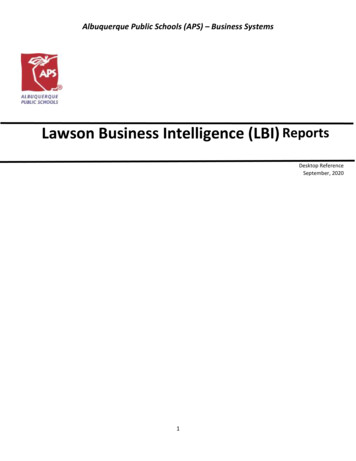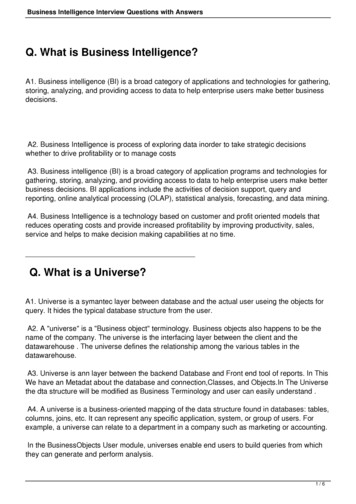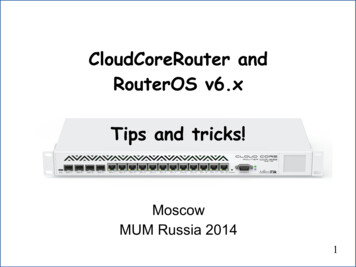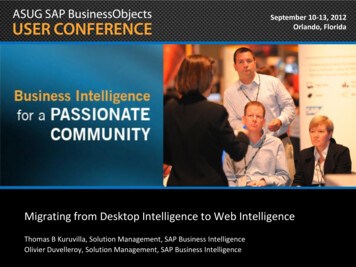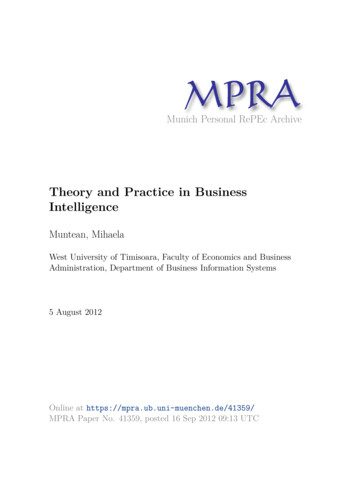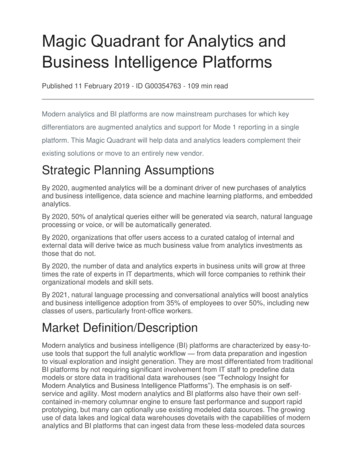
Transcription
Modern Business IntelligenceThe Path to Big Data AnalyticsApril 2018
The Path to Big Data Analytics IntroductionIntroductionIn a world where the amount of data produced grows exponentially, federal agencies and ITdepartments face ever-increasing demand to tap into the value of enterprise data. With thepotential to increase business value and overall mission effectiveness, many agencies are seekingnew and innovative ways to turn organizational data into valuable insights. Making sense of thetechnologies, tools, and, techniques required to derive insights from such vast amounts of data canseem overwhelming. However, a modern enterprise analytics solution often doesn’t require acomplete reboot of previous investments. By investing in a modern business intelligence (BI)platform that complements existing business intelligence systems, businesses can expand theirrange of insight-driven capabilities. With this investment comes a shift in data ownership from IT tobusiness groups, giving more users the power to answer any question, with any data, at any time.By implementing a modern BI platform, federal agencies can use analytics to more effectivelyachieve mission objectives such as protecting and maintaining the health of the American people,keeping the country safe and secure from foreign and domestic threats, and preventing waste,fraud, and abuse of government resources.In this paper, we discuss the challenges of traditional business intelligence and reporting, the needfor solutions that answer today’s toughest data challenges, and the accompanying people,processes, and technology that support the shift to modern enterprise analytics.Traditional Business Intelligence PlatformsThe traditional Business Intelligence platforms of the past two decades have chiefly succeeded inproviding users comprehensive historical reporting and user-friendly ad-hoc analysis tools. Theavailability of this functionality is largely due to the underlying data architecture, which consists ofa centralized data storage solution such as an Enterprise Data Warehouse (EDW). EDWs form thebackbone of traditional data platforms and often connect an immense web of source systems into acentral data repository. Data is then standardized, cleansed, and transformed in the EDW beforebeing pulled into various reports and dashboards to display historical business information, such asquarterly sales or weekly revenue metrics. While traditional BI offers a basis for these types ofdashboards and ad-hoc reporting, this IT-developed solution has presented its own uniquechallenges.While users have been able to gain tremendous value from traditional platforms for historicalreporting capabilities, more users now require data analyses techniques that require direct accessto data without relying on IT specialists. The following challenges associated with traditional BIsolutions have been highlighted by federal agencies in the analytics space: Lack of On-Demand Analysis Capabilities – Today’s advanced BI users don’t want to waitto get answers to their most complex business problems. More users require self-servicecapabilities in to relate and analyze specific data sets based on their own understanding, at anytime, for any purpose. Need for Predictive Analyses – Historical reporting capabilities only provide one piece of thepuzzle: insight into what happened in the past. To truly become data driven and forwardthinking, businesses are looking to predictive analytics – or insight into the future. Withpredictive models, businesses can use patterns and forecasting to gain actionable next stepsbased on their data. Analysis of Mixed Data Types – Traditional BI Platforms have largely been focused onstructured data, but today, users need the ability to also view and analyze semi-structured,unstructured data, and third party data. The sheer amount of information produced hasskyrocketed in recent years, in part due to the Internet of Things (IoT), new data mining1
The Path to Big Data Analytics Introductiontechniques, and the proliferation of sensors and other automated data collection tools. Datascientists and advanced BI users now require access to untapped data in various formats,where they have the ability to create their own algorithms and blend data types, and whereinsights are available on demand for rapid and accurate decision-making.Many organizations that lack the people, processes, and technology necessary to expand their dataanalysis capabilities to the next level become discouraged. These challenges require an analyticsplatform and strategy that goes beyond the breadth of traditional BI platforms, as seen in Figure1.Figure 1: As organization investment in data modernization increases, value grows exponentially andchanges from hindsight to insights to foresight.This document demystifies modern business intelligence technologies and helps explain how themodern platform can co-exist in a traditional BI reporting environment to expand the capabilities ofthe businesses in the realm of data exploration and advanced analytics.2
The Path to Big Data Analytics What is a Modern Business Intelligence Platform?What is a Modern BusinessIntelligence Platform?While traditional BI platforms often provide analyses that answer the question “What happened?” ina historical perspective, modern platforms have the ability to answer the question of “What ishappening, what will happen, and why?”, offering the ability to not only obtain and monitor acontinuous pulse of the organization through rapid analytics, but to accomplish mission objectivesthrough predictive analytics.Integrating Traditional and Modern BI PlatformsData platform changes are necessary to shape the foundation for an enterprise-wide datatransformation and organizations are rightfully wary of scrapping their entire IT architecture andstarting fresh. Data warehouses continue to play a key role in existing data platforms, providingthe thoroughly cleansed, organized, and governed data needed for most businesses. The datawarehouse allows business executives and others without deep technical knowledge to gaininsights from historical data with relative ease. This data, sourced from the data warehouse, ishighly accurate due to IT scrubbing, rigorous testing, and thorough knowledge of layers of the databy IT specialists. However, the challenges associated with traditional BI are creating demand foraugmenting an EDW with another form of architecture optimized for quick access to ever-changingdata: the Hadoop Data Lake.Organizations looking to modernize their analytics platforms have started to adopt the concept ofdata lakes. Data lakes store information in its raw and unfiltered form, be it structured, semistructured, or unstructured. As opposed to the stand-alone EDW, data lakes themselves performvery little automated cleansing and transformation of data, allowing data to therefore be ingestedwith greater efficiency, but transferring the larger responsibility of data preparation and analysis tobusiness users.Using Hadoop’s distributed file system (HDFS), data lakes offer a low-cost solution for efficientlystoring and analyzing many types of data in its native form. A data lake solution coupled with adata warehouse defines the next generation of BI and offers an optimal foundation for dataanalysis, as shown in Figure 2.3
The Path to Big Data Analytics What is a Modern Business Intelligence Platform?Figure 2: Data begins in source systems on the left. The data warehouse receives data in large batchesfor BI reporting, while the data lake collects raw organizational data used for advanced analytics anddata discovery.In the system displayed in Figure 2, the EDW receives system data from various sources throughan ETL (Extract, Transform, and Load) process. After being cleansed, standardized, andtransformed, the data is ready for analysis by a wide variety of users via reports and dashboards.Meanwhile, the data lake collects raw data from one, many, or all of the source systems, and datais ingested and immediately ready for discovery or analysis. The result: a wider user baseexploring and creating relationships between enormous amounts of diverse data for individualanalyses, on demand.Understanding Your Data within a Modern BI EnvironmentWhile the data lake can quickly ingest and store organizational data, it does not provide a one-sizefits all solution for every data type. As seen in Figure 3 below, the higher the complexity andveracity (required precision) of the data, the greater the need to cleanse, transform, and organizethe data. Data lakes offer the ability to do all three, but may not always be the most effectivesolution. Given this, there is a tradeoff of having quick access to raw, unfiltered data, or spendingthe time to cleanse and prepare data based on business requirements.4
The Path to Big Data Analytics What is a Modern Business Intelligence Platform?Figure 3: The higher the veracity and complexity of the data set at hand, the more cleansing,transforming, and organizing the data set will require.For example, a monthly costing report which requires auditor precision may be better suited fordevelopment in a traditional data warehousing model where financial subject areas can beestablished, calculations are defined, thorough testing completed, and predefined reports built. Onthe other side of the business, machine and log data present a classic use case for the data lake.Log, sensor, and other streaming data are great candidates for data lakes given their semistructured and flat, less-complex nature. Often, it does not make sense to spend time modeling,loading, and converting log data into a reporting structure within the data warehouse. This processcan be arduous, and can be further complicatedwhen an analysis involves additional data,Rapid Insights at a Federalrequiring additional data modeling and ITManufacturing Facilityprocessing. Conversely, loading data into thedata lake can be done with relative ease due toA federal manufacturing facility needed quickerthe limited amount of conversions andaccess to large volumes of data in its nativetransformations initially required. With the dataformat in order to scale and adapt to thelake, open-ended data discovery and analysischanging needs of the business. The Deloitteallows any questions to be asked, and datateam implemented a Hadoop Data Lake tostructures or sets to be determined in support ofcomplement the client’s existing datathose questions on-demand.warehouse in order to support self-service andopen-ended data discovery. By using the dataBeyond the Foundationlake, users are be able to perform advancedA modern BI platform allows a wider base ofanalytics of sensor and log data and analyzeemployees to leverage huge amounts of data forvarious file types on-demand.rapid, insight-driven decision-making. However,the platform is only the foundation for advancedanalytics. The people, processes, andtechnologies that support the platform ultimately drive the impact of the system’s ability to deriveinsights and achieve mission objectives. In the following section, we will discuss topics ofconsideration when managing a modern business intelligence solution.5
The Path to Big Data Analytics Modern Business Intelligence ManagementModern Business IntelligenceManagementA BI Platform without data management is a data swamp – a place where data goes in, but isunable to be retrieved or provide the desired value. Modern business intelligence data managementfocuses on increasing the value, and thus impact, of the modern business intelligence investment.It is important to discuss how data lakes can, and should be, divided into three zones. These zonesaid in the process of data loading, defining user access and security, and creating a more userfriendly environment. The zones are depicted and described in more detail in Figure 4.Figure 4: Data becomes increasingly cleansed and standardized as it moves from Zone 1 to Zone 3. Zone 1, the landing region, consists of raw, untransformed data gathered directly from thesource systems. Here, data is often automatically ingested and maintained by IT, with verylittle room for manipulation. Zone 2, the data sandbox, where data is lightly processed, cleansed, and combined forexploration and analysis. Each user may have a private region alongside a collaborative, sharedregion, and security control is typically less strict than the landing and publishing zones. Zone 3 consists of refined data, stored in its optimal form for reporting or treated as trusteddata. Often called the production zone, Zone 3 has the strictest governance controls. Datastored here can be considered a published, trusted data set, and can be used or manipulated inthe data warehouse or by other users for analysis.To provide an analogy, Zone 1 is like finding a diamond in the rough. It is raw and uncut, and maynot look like it has much value without performing additional processing. Zone 2 is where thediamond is cut and polished. Just like preparing data, diamond cutting requires specialized skills,tools, and techniques. It is then able to be examined for cut, clarity, color and other measures. Ifthe diamond is found to be of value, it would then be sent to Zone 3, or made available to others.The true value is now known and the diamond can be sold or placed in a setting – similar to usinganalyses developed within the data lake on a predictive analysis or dashboard in the datawarehouse.In this section we provide the three keys to keeping a modern BI platform from turning into aswamp: effective governance and data enhanced with metadata, selecting and leveraging the right6
The Path to Big Data Analytics Modern Business Intelligence Managementsoftware products, and adopting organizational change. We will discuss these three keys in moredetail below.Governance, Metadata, and SecurityAny analytics platform is only as useful as its data. While governance may not seem imperative orvaluable for small data sets, proper standards are crucial as the data platform scales toaccommodate an entire agency or several agencies. Governance is typically defined as an internalbody that helps organizations oversee changes to analytics solutions and processes, resolveanalytics/data issues, and facilitate decision making amongst agency stakeholders. As part of itsregular duties, the governance body helps prioritize data sets to be ingested into the data lake,defines best practices for performing analyses and creating efficient self-service data sets, and setsthe criteria for publishing data sets for other users.As higher volumes of data are ingested into the data lake, the risk of misinformation andincomplete or undefined data grows, reducing the overall usefulness of the data stored, andultimately the quality of any downstream analyses produced. This is where Metadata Managementcomes in to play. Metadata management can best be illustrated by considering a library. The booksrepresent various pieces of data; as the library grows, it is important to catalog, index, anddescribe each book in the context of larger categorizations, such as genre, publication date, andauthor name. In any large library, it would be impossible to locate books without a sorting method.In the same way, designing a metadata process from the beginning enables efficient dataorganization and trust throughout the pipeline, preventing the data lake from degrading. Effectivemetadata management not only builds trust through clearly identified data, but also enables sharedknowledge of how data is defined and related, expediting future analyses.Security also plays a key role in the development and proper use of a data lake solution.Comprehensive identify management and authentication systems are key to controlling access tocontent stored in the data lake. Role-based access and security groups offer a way to regulatewhich users have the ability to access and interact with the data lake, minimizing the risk of noncleared users accessing potentially sensitive or confidential data. Through these processes,agencies can increase the consistency with which users can locate and trust data, increasing useradoption and trust.Analytics SoftwareToday's modern analytics software provides the ability to power both agency decision making andcomprehensive growth. In order to support modern analytics capabilities, today’s analytic softwaremust power the following components of data analysis: Data Ingestion describes the tools and software that collect and store the various types ofdata in Zone 1 and making them available for analytics. Logs and streaming data requiredifferent ingestion mechanisms than data residing in a database. Various open source andcommercial software can ease the data ingestion process with flows and visual representationsof the process from various data sources. Data Preparation, or data wrangling, is the cleansing, consolidation, and standardization ofdata prior to data analysis that is typically performed in Zone 2. With the responsibility of datapreparation now falling into the hands of the business user, software is emerging to aid in theheavy lifting. With well-documented metadata, users can input the expectations and rules forhow data should be processed, resulting in a user-prepared and tailored data set. Data Discovery is used for analyzing patterns and relationships through summary statistics,what-if analysis, and visualizations and is also performed in Zone 2. Many visualizationsoftware products are able to connect and combine data from both data warehouse and datalake platforms, yielding results not previously possible given the nature of structured andunstructured data. There are two reasons it is important to select software that leverages thedata platform when performing analysis. First, results should be processed in the platform, not7
The Path to Big Data Analytics Modern Business Intelligence Managementusers’ desktops, which yields much more efficient results due to scaled architecture. Second,once data sets have been created, it’s important for those results to be easily shared withproper security.Advanced Analytics consists of a collection of data analysis techniques that expand beyondhistorical reporting and trend analysis to gain deeper insights, actionable intelligence, and nextsteps from diverse sets of data. The data lake platform supports software and languages thatpower the tools necessary for enabling advanced analytics. Methods such as machine learning,artificial intelligence, data and text mining, network/cluster analysis, sentiment analysis, andrandom forest regressions are changing and shaping the future of modern analytics. Forexample, through predictive regression analysis of population data, a data scientist can maphow average temperature, populationdensity, and proximity to standing waterAdvanced Analytics at CFPBrelates to the spread of disease. From there,agencies could identify target locations thatThe Consumer Financial Protection Bureauare most at risk and potential solutions for(CFPB) was receiving large volumes ofmitigating the risk of an outbreak.unstructured data in the form of 40,000consumer complaints each month. DeloitteEnabling Insight-Driven Organizationsimplemented an analytics solution based onAccompanying any technological shift is a changemachine learning, advanced data mining, andin tools, processes, and equally as important,algorithms to find new insights andpeople and behavior. Even with the mostautomatically classify consumer complaints.cutting-edge technology and well-documentedThe solution developed by Deloitte is nowprocesses, users need to feel empowered toprocessing over 40,000 complaints a month,adopt modern BI solutions, as they are the oneswith accuracy exceeding that of humans bywho will drive insight-driven decision making. For30%.that to happen, the organization must have theskills and knowledge as it relates to data. Theshift to a modern business intelligence solutionrequires support to the user in the followingforms, to name a few: Culture of Ownership – With the shift to self-service technologies at the forefront of theanalytics space, it is important to recognize that the power of data is moving to the hands ofthe user. Helping users understand the ways in which they can use the modern BI platform –and use it correctly - will support employees to feel empowered and incentivized to operateindependently in the new technical environment. End User Training – Standing up a new business intelligence platform without organizingproper training and available change management support almost guarantees a lack ofcommitment from the target users. User training is key to aspects of the transition – fromplatform training (such as the nuances of operating Hadoop) to training within the visualizationtool. Hands-on training sessions, deep dives, and ongoing support should be available topotential users. Community of Engagement – While users may have received the technical training requiredto physically use the tool, keeping user interest from waning is key to a platform’s adoptability.By fostering interest through interactive workshops, office-specific demos, and clear means ofcommunication, effective data management can keep users active and interested, spreadawareness, and preserve the momentum once the technical transition itself is complete.Investing in people upfront simplifies the shift from a traditional platform to a modern BI solution,preparing users from the start to get the most out of this new investment.8
The Path to Big Data Analytics ConclusionConclusionToday’s BI landscape is rapidly changing and doesn’t show signs of slowing down. The challengesassociated with traditional business intelligence platforms have driven business leaders to look formodern, forward-looking, flexible solutions. Modern business intelligence platforms helporganizations take advantage of mass amounts of existing and new information in vastly differentways than were previously possible, allowing users to ask and find answers to any question, withany data, at any time. To do this, organizations don’t have to replace their existing data platformsbut rather leverage existing investments and expand capabilities by augmenting with modern toolsand technologies.As self-service analytics technology continues to put more power and responsibility into the handsof the business user, the need for proper management of modern solutions becomes critical. Withproper tools and software, established processes, and comprehensive change management,organizations can save time, resources, and better achieve mission effectiveness by harnessing thepower of data to become modern, data-driven, insight-driven agencies.Contact UsPaul Needleman is a Manager with Deloitte Consulting LLP and based in the Rosslyn office. Hehas more than 11 years of experience in delivering enterprise data solutions to the FederalGovernment and currently serves as the Enterprise Data Architect at a federal manufacturingfacility. Paul Needleman can be reached at pneedleman@deloitte.com.Mary Kate Sternitzke is a Consultant with Deloitte Consulting LLP and based in the Rosslynoffice. She has experience in delivering analytic solutions through the full SDLC and is currentlyserving as a functional analytics lead at her federal client. Mary Kate Sternitzke can be reached atmsternitzke@deloitte.com.9
About DeloitteDeloitte refers to one or more of Deloitte Touche Tohmatsu Limited, a UK private company limited byguarantee (“DTTL”), its network of member firms, and their related entities. DTTL and each of itsmember firms are legally separate and independent entities. DTTL (also referred to as “DeloitteGlobal”) does not provide services to clients. In the United States, Deloitte refers to one or more ofthe US member firms of DTTL, their related entities that operate using the “Deloitte” name in theUnited States and their respective affiliates. Certain services may not be available to attest clientsunder the rules and regulations of public accounting. Please see www.deloitte.com/about to learnmore about our global network of member firms.Copyright 2018 Deloitte Development LLC. All rights reserved.
The Path to Big Data Analytics What is a Modern Business Intelligence Platform? 4 Figure 2: Data begins in source systems on the left. The data warehouse receives data in large batches for BI reporting, while the data lake collects raw organizational data used fo


